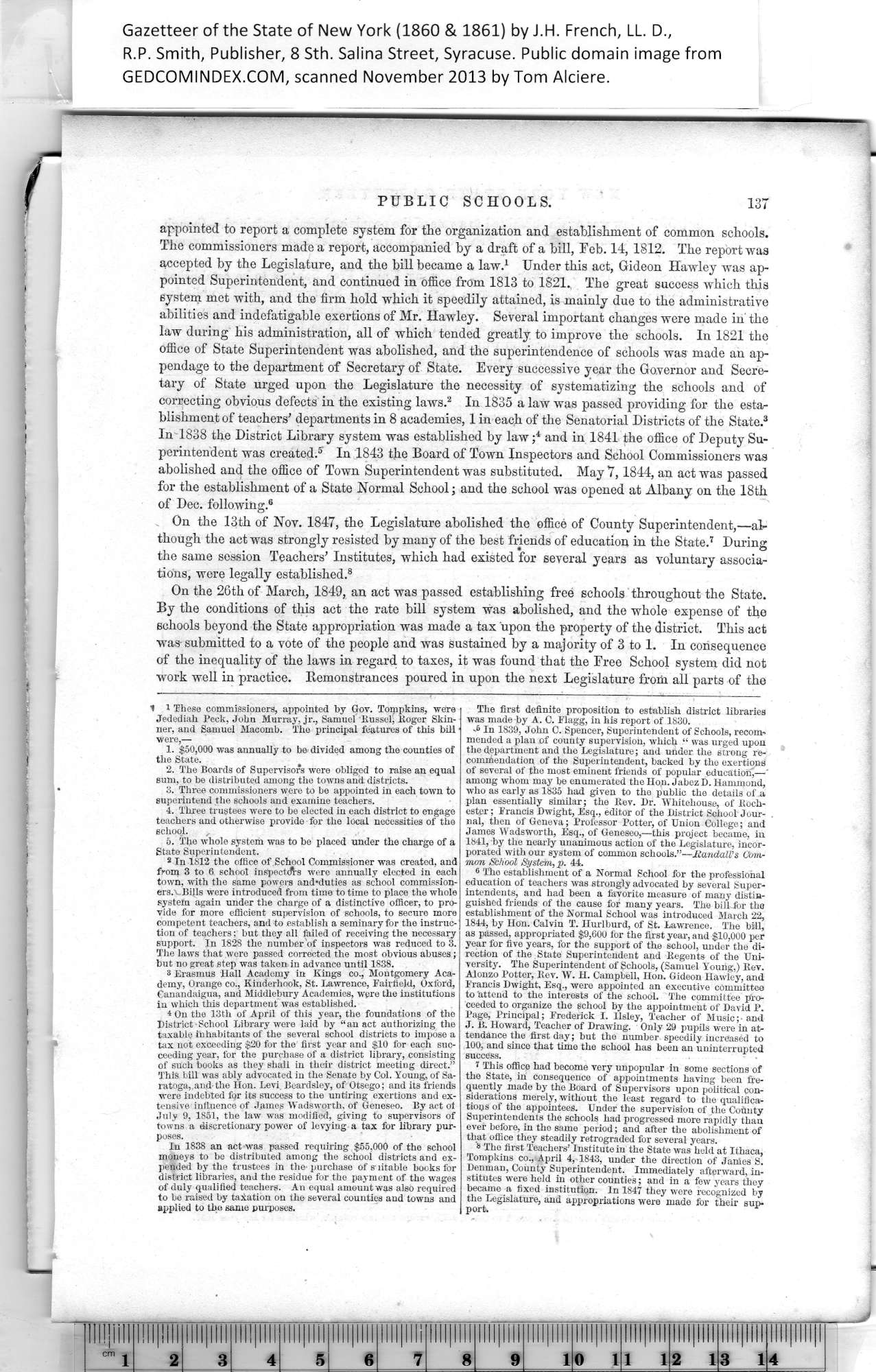|
PUBLIC SCHOOLS. 137
appointed to report a complete system for the organization and establishment of common schools.
The commissioners made a report, accompanied by a draft of a bill, Feb. 14, 1812. The report was
accepted by the Legislature, and the bill became a law.1 Under this act, Gideon Hawley was ap¬
pointed Superintendent, and continued in office from 1813 to 1821. The great success which this
system met with, and the firm hold which it speedily attained, is mainly due to the administrative
abilities and indefatigable exertions of Mr. Hawley. Several important changes were made in the
law during his administration, all of which tended greatly to improve the schools. In 1821 the
office of State Superintendent was abolished, and the superintendence of schools was made an ap¬
pendage to the department of Secretary of State. Every successive year the Governor and Secre¬
tary of State urged upon the Legislature the necessity of systematizing the schools and of
correcting obvious defects in the existing laws.2 In 1835 a law was passed providing for the esta¬
blishment of teachers’ departments in 8 academies, 1 in each of the Senatorial Districts of the State.3
In 1838 the District Library system was established by law ;4 and in 1841 the office of Deputy Su¬
perintendent was created.5 In 1843 the Board of Town Inspectors and School Commissioners was
abolished and the office of Town Superintendent was substituted. May 7,1844, an act was passed
for the establishment of a State Normal School; and the school was opened at Albany on the 18th
of Dec. following.2
On the 13th of Nov. 1847, the Legislature abolished the office of County Superintendent,—al¬
though the act was strongly resisted by many of the best friends of education in the State.7 During
the same session Teachers’ Institutes, which had existed for several years as voluntary associa¬
tions, were legally established.8
On the 26th of March, 1849, an act was passed establishing free schools throughout the State.
By the conditions of this act the rate bill system was abolished, and the whole expense of the
schools beyond the State appropriation was made a tax upon the property of the district. This act
was submitted to a vote of the people and was sustained by a majority of 3 to 1. In consequence
of the inequality of the laws in regard to taxes, it was found that the Free School system did not
work well in practice. Remonstrances poured in upon the next Legislature from all parts of the
|
The first definite proposition to establish district libraries
was made by A. C. Flagg, in his report of 1830.
-5 In 1839, John C. Spencer, Superintendent of Schools, recom¬
mended a plan of county supervision, which “ was urged upon
the department and the Legislature; and under the strong re¬
commendation of the Superintendent, backed by the exertionB
of several of the most eminent friends of popular education,—'
among whom may he enumerated the Hon. Jabez D. Hammond,
who as early as 1835 had given to the public the details of a
plan essentially similar; the Rev. Dr. Whiteliouse, of Roch¬
ester ; Francis Dwight, Esq., editor of the District School Jour¬
nal, then of Geneva; Professor Potter, of Union College; and
James Wadsworth, Esq., of Geneseo,—this project became, in
1841, by the nearly unanimous action of the Legislature, incor¬
porated with our system of common schools.”—Randall’s Gam¬
mon School System, p. 44.
e The establishment of a Normal School for the professional
education of teachers was strongly advocated by several Super¬
intendents, and had been a favorite measure of many distin¬
guished friends of the cause for many years. The bill for the
establishment of the Normal School was introduced March 22,
1844, by Hon. Calvin T. Hurlburd, of St. Lawrence. The bill,
as passed, appropriated $9,600 for the first year, and $10,000 per
year for five years, for the support of the school, under the di¬
rection of the State Superintendent and Regents of the Uni¬
versity. The Superintendent of Schools, (Samuel Young,) Rev.
Alonzo Potter, Rev. W. H. Campbell, Hon. Gideon Hawley, and
Francis Dwight, Esq., were appointed an executive committee
to attend to the interests of the school. The committee pro¬
ceeded to organize the school by the appointment of David P.
Page, Principal; Frederick I. llsley, Teacher of Music;-and
J. B. Howard, Teacher of Drawing. Only 29 pupils were in at¬
tendance the first day; hut the number speedily increased to
100, and since that time the school has been an uninterrupted
success.
1 This office had become very unpopular in some sections of
the State, in consequence of appointments having been fre¬
quently made by the Board of Supervisors upon political con¬
siderations merely, without , the least regard to the qualifica¬
tions of the appointees. Under the supervision of the County
Superintendents the schools had progressed more rapidly than
ever before, in the same period; and after the abolishment of
that office they steadily retrograded for several years.
8 The first Teachers’ Institute in the State was held at Ithaca,
Tompkins co., April 4, 1843, under the direction of Janies S.
Denman, County Superintendent. Immediately afterward, in¬
stitutes were held in other counties; and in a few years they
became a fixed institution. In 1847 they were recognized by
the Legislature, and appropriations were made for their sup¬
port. |
1
1 These commissioners, appointed by Gov. Tompkins, were
2
moneys to be distributed among the school districts and ex¬
|
